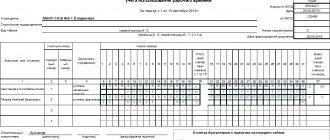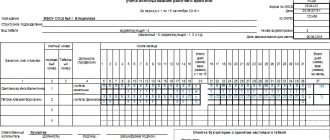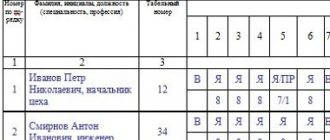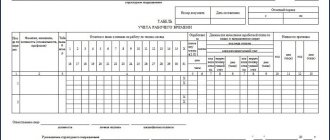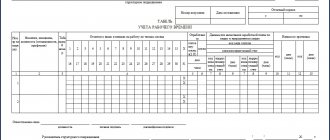A fair calculation of remuneration for labor directly depends on the correct recording of employee working time. Thus, the parties to the labor relationship are relieved of any claims against each other. The obligation to take into account the hours worked by the employee rests with the employer.
It is important to note that the Labor Code of the Russian Federation limits the maximum number of hours that a worker can work during the working week. For violation of this norm, the administration may be held legally liable.
What is working time according to the Labor Code of the Russian Federation
The legislation (Labor Code of the Russian Federation) gives a clear definition of the concept of working time - this is the time that an employee performs the labor functions assigned to him, as well as other periods that, at the legislative level, are equated to working time.
It is important to highlight some nuances here:
- Working hours include all duties prescribed by the employment contract. In other words, the parties initially agreed on what the employee would be paid for. And this time needs to be worked out and taken into account.
- Other periods determined by law. In this case, some features of domestic legislation should be taken into account. In fact, all periods when an employee is on the territory of the enterprise are taken into account during working hours. This includes downtime, technological breaks, and periods to meet physiological needs. An exception is if a worker unauthorizedly (without consent or approval from the administration) entered the company’s territory.
- Please note that the Labor Code of the Russian Federation introduces a limit on the normal duration of work per week. The maximum number of hours should not exceed 40 hours. But there may be exceptions to every rule. This time limit may decrease (work in hazardous industries, disabled people, minors), or slightly periodically increase (rotation work or shift work with cumulative accounting).
Remember, keeping track of the time employees work at the workplace is the direct responsibility of their employer. And the employee has every right to control this process.
"Working time tracking"
3. Time tracking
The concept of working hours is closely related to the issue of recording working hours.
Working time tracking is a recording of the time that an employee worked at the workplace while performing his job duties.
There are several main types of working time recording:
1. Daily recording of working hours - long working hours is established by the internal work schedule and is indicated in the employment contract. All work performed by an employee beyond the established time is considered overtime and is paid additionally. Time worked is recorded daily.
2. Weekly recording of working hours - carried out with a work schedule extended to a week, which is previously developed by the employer and discussed with the employee (employees). Time recording is carried out once a working week.
3. Summarized recording of working time - the period of working time can be increased within a period from 1 month to 1 year. When conducting this type of accounting, the average length of time that employees spend on performing their duties must correspond to the established average working day1.
Summarized working time recording is used mainly in those organizations where the need for overtime work quite often arises, as well as in organizations where the rotational principle of labor coordination is applied. This need is due to the fact that the implementation of the average calculation of working hours allows you to bring the deviation back to normal and make an accounting.
If the enterprise has established summarized time tracking, the work schedule can be drawn up in two versions:
1. A schedule with a different number of hours, which are distributed among the days of a specific reporting period.
2. Schedule, with a strictly fixed duration of each working day2.
As part of the coordination of the work process, each enterprise issues specific internal documents for this purpose:
- time sheet,
- changeable schedules,
- orders, etc.3
It should be noted that relatively recently, all of these documents had to be created and filled out in accordance with established standards. Since 2013, the situation has changed. Each enterprise or organization has the right to independently determine the type and form of this document, as well as the procedure for its completion and maintenance.
Despite the fact that enterprises have a certain independence in this matter, the majority still use the forms that were introduced and established by the State Statistics Committee. This is explained by the fact that these forms are quite convenient, understandable, simple and functional.
Thus, the schedule can be compiled using the T-12 form, which is filled out manually, or it can be compiled using the T-13 form, which is filled out automatically. Regardless of the type and form, both options must be stored in a single copy, signed by the responsible parties.4.
In accordance with established standards, the working time sheet must be stored for 5 years from the date of its development. However, there are a number of exceptions. So, if a working time sheet was developed at an enterprise where working conditions are considered dangerous or harmful, then its shelf life increases to 50 years.
When developing a working time schedule at an enterprise, they take into account, first of all, the characteristics of the enterprise’s activities, as well as its production calendar for the current year. This document must include:
1. Standards of working time for each month, quarter and the entire calendar year as a whole. In this case, the working week can be 24, 36 or 40 hours.
2. Established standards for the number of working days and days off, with a five-day working week.
3. Information about additional days off (public holidays), as well as information about the transfer of weekends and working days5.
To accurately monitor and record the working time of each employee of an enterprise, an individual shift, or all employees in general, a variety of methods and means can be used. Methods and means are selected by the enterprise independently, based on the one that will be more convenient and rational.
Methods and means of monitoring working time recording:
1. Log book - this is one of the most popular and widely used options. Despite all the old-fashionedness and rather complicated procedure, this method remains one of the most common. Currently, it is used in many companies and enterprises. The journal is a document that the responsible person fills out manually.
2. Computer technologies are specially developed applications that track the time an employee is at work, as well as the time the employee spent at his work PC. In addition, computer programs allow you to monitor telephone calls by recording them, photographing your desktop at certain intervals, monitoring messages sent through corporate email, etc.
3 Access control and management systems (ACS) are systems that allow you to control the access of employees to certain premises and to specific objects, but also, if necessary, limit them to the specified capabilities. In addition, this system allows you to establish a clear time during which the employee was on the territory of the enterprise.
4. Biometric systems. They allow you to find out how much time an employee actually worked during a certain period of time, thanks to access systems that use biometric parameters. This option is suitable for companies for which the rational use of wages is of paramount importance. It is more advanced than, for example, an access control system with a plastic access card.
5. Video surveillance is a specially designed computer program that can be fully automated, or can be partially automated and controlled by a person. If the system is fully automated, then it itself takes into account the time the employee is at the workplace. If the system is partially automated, then the recording of working time, that is, the time spent at the employee’s workplace, is carried out by a special employee who supervises the work process. This method is one of the most effective, since the system allows you not only to monitor that employees are at the workplace, but also to evaluate their labor productivity.
6. A working time tracking program (system) is specialized software (software) that is created to automate the recording of working hours and the presence of employees at work PCs. Currently, this type of time tracking is one of the most popular. The software is capable of not only recording the time an employee arrives and leaves work, but also the time he spends at his workplace, the time he works on a work PC, as well as which programs and which sites were used by the employee during working hours. Based on this data, the program generates working time reports that show statistics in the form of charts for each employee or department. An example of such a program is Kickidler6.
For the purpose of keeping records of working hours, a responsible person is appointed in the organization. The appointment is made by the management of the organization. His job responsibilities include maintaining work schedules and timetables.
Appointment to a position is carried out in accordance with a number of rules, requirements and conditions:
1. If the organization is not large, then working time recording is carried out by one of the part-time employees. That is, the employee fulfills his job duties and additionally keeps track of working hours, draws up schedules and timetables.
2. If the organization has a sufficient number of employees and is medium in size, then management creates a special position (for example, accountant or timekeeper). The main task of such an employee is to draw up schedules, schedules, track working hours, delays and tardiness, overtime work, etc.
3. In large organizations, a special position for recording working hours is introduced in each department7.
Regardless of the option, the position of a working time recorder (a separate position or combined with the main responsibilities), the functions assigned to the employee for recording and monitoring working time are fixed in his employment contract, as well as in the job description. The appointment is approved by an order, which must be signed by the head of the organization8.
After all the necessary signatures have been placed on this document, it is sent to the accounting department.
Monitoring working hours is a necessity and responsibility of every organization. In addition, all accounting documents must be completed correctly, in accordance with the procedure established by law.
If an organization violates the Labor Code of the Russian Federation in terms of establishing working hours and recording them, then it bears administrative punishment in the form of a fine.
In accordance with Art. 5.27 of the Code of Administrative Offenses of the Russian Federation, fines may be imposed on an enterprise:
1. Violation of legal standards of labor and its protection - an administrative fine for legal entities from 1 thousand to 5 thousand rubles.
2. Violation of legal standards of labor and its protection - an administrative fine for individual entrepreneurs ranges from 1 thousand to 5 thousand rubles, or forced suspension of activities for up to 90 days.
3. Repeated violation of legal standards of labor and its protection - an administrative fine for a legal entity ranges from 30 thousand to 50 thousand rubles, or forced suspension of work for up to 90 days9.
Thus, organizations have the right to some liberties in establishing working hours and preferring methods for recording them, but all this must fit within the framework of the requirements established by law.
Dzgoeva-Suleymanova F.O. Labor law in questions and answers: textbook // F.O. Dzgoeva-Suleymanova / M.: Prospekt, 2021 – P. 117-128
Dzgoeva-Suleymanova F.O. Labor law in questions and answers: textbook // F.O. Dzgoeva-Suleymanova / M.: Prospekt, 2021 – P. 117-128
See ibid p. 131
Mironov V.I. Labor law: textbook // V.I. Mironov / M.: Prospekt, 2021 – pp. 713-715
Mironov V.I. Labor law: textbook // V.I. Mironov / M.: Prospekt, 2021 – pp. 713-715
Gusov K. N., Andreev A. A., Bondarenko E. N. Labor law of Russia. Textbook for bachelors. - M.: Prospekt, 2021 - P. 156-189
Afanasyev M.A. Labor law. Educational and methodological manual // M.A. Afanasyeva / M.: Prospekt, 2021 – pp. 77-81
Gladkov N. G., Brilliantova N. A., Volkova O. N. Labor law. Textbook. - M.: Prospekt, 2021 - P. 319-335
“Code of the Russian Federation on Administrative Offences” dated December 30, 2001 N 195-FZ (as amended on June 23, 2020) (with amendments and additions, entered into force on July 4, 2020) // [Electronic resource]. – Access mode: https://www.consultant.ru/ (date of access: 07/10/2020)
Types of accounting
The law obliges the administration to ensure reliable records of all hours worked by workers. But there are no specific requirements for companies regarding who is obliged to fulfill this and how. Therefore, in practice, time worked is calculated as follows:
- Daily accounting . In this case, all hours worked per day should be immediately displayed on the timesheet. This accounting method is suitable in companies where employee labor is clearly rationed. To pay wages, you must total all hours worked for the month. It must be taken into account that shortcomings in some days with such an accounting system will not be compensated by overworking hours in other periods. We will have to simultaneously count the shortcomings and rework.
- Weekly accounting . A very common accounting system. In this case, all hours worked during the week are taken into account. At the same time, overtime on one day (for example, if an employee worked 10 hours at a standard of 8 hours) can be compensated for by underwork in another period (this is if, at a standard of 8 hours, the employee worked only 6 hours). Payment of remuneration here can be made for the week worked, or summed up and paid per month.
- Summarized accounting . Here it is supposed to select the optimal period of work, which will minimize the number of overtime hours. Typically this period is a month. Less often - a quarter, half a year. For certain categories of seasonal workers, this may even be a year. Periods longer than a year are not established. Here it is important to understand that only those hours that “come out” after the close of the period will be overtime (or underworked). Regardless of the accounting period, salary payments must be made monthly (twice a month based on advance payment and final payment).
Remember, the method of recording hours worked is established by the administration, based on the specifics of the work of a particular company. Every employee of the company is informed about this during employment.
Entering timesheets
The document Entering Time Sheets is intended to enter or correct data on deviations entered during the payroll period before calculating wages.
The document provides the opportunity to indicate the type of absence in accordance with the classifier of the use of working time.
Data in the timesheet, as well as in the previous document discussed, can be entered cumulatively or by day of the period. If the data is entered collectively, for each type of working time in the tabular part of the document you can display a column in which information about the number of days and hours of absence is indicated. The visibility of table columns is configured using the Change column composition button on the table command panel; no more than six types of time can be used in a row at a time.
The document can be automatically filled in with data on employees’ working hours, while the tabular section will display all the employee’s working days in accordance with the previously entered individual work schedule, and if there is none, in accordance with the work schedule, as well as all absences and additional payments of the employee, information about which has already been entered into the program (see Fig. 5).
Rice. 5
When editing a time sheet with a summary method of entering time, you must remember that when entering data on the time of absence, the time of attendance is not automatically recalculated. Thus, if the user entered information about a two-day leave without pay for an employee in the time sheet, but did not reduce the number of days of attendance, the employee’s salary will be calculated based on data on the fully worked month.
A document with a method for entering time by day of the period provides the user with a table in which for each day of the billing period one or more working time designations can be entered, indicating the number of hours of this time. Types of time are designated using letter codes defined in the reference book Classifier of the use of working time. If you need to enter several types of use of working time on one day, you can enter several letter designations with hours worked, for example: “I-6, N-2”.
When entering time by day of the period, the time sheet (see Fig. 6) can be drawn up both for the full month and for its part: the first or second half of the month; arbitrary period within a month. With consolidated data entry, the document can only be issued for a full month.
Rice. 6
It is imperative to keep in mind that, despite the ability to edit time worked and absences using a time sheet, the calculation of the amount of payment for absences and the amount of additional charges is carried out by special primary documents of the system. For example, entering information about an employee’s two-day business trip in a timesheet will not automatically calculate the amount of payment based on average earnings. To calculate payment for a business trip, the document Payment based on average earnings must be entered. Information about absences entered into the time sheet will only affect the calculation of payment for time worked.
To pay for work at night and in the evening, in addition to the schedule, individual schedule or time sheet, it is necessary that for this employee the document Entering information about planned accruals of employees of the organization indicating the amount of payment for evening and night hours must be drawn up. Payment amounts are calculated using the document Calculation of salaries for employees of the organization.
The timesheet has the opportunity to indicate the types of time classified as time worked in excess of the norm - overtime hours or time worked on holidays. Please note that without completing the appropriate primary documents, payment for overtime is not registered in the program, even if the overtime is reflected in the document Entering time sheets. This is explained by the fact that overtime is paid separately from the main salary, and its presence, unlike absences, does not affect the calculation in any way.
The consequence of this algorithm is that when printing from a T-13 form document, information about overtime hours worked or work on holidays will not be reflected in printed form until the documents Payment for overtime hours or Payment are entered into the program work on holidays and weekends. Let us remind you that when printing from a document, the T-13 time sheet form is filled in with data on time worked and employee absences based on the results of all previously entered primary documents and deviation documents, and not just according to the time sheet data. It is also important to remember that the T-13 form can be printed from a document only when entering time by day of the period; the T-13 form cannot be printed from a “consolidated” timesheet.
Control methods
Modern technical means provide expanded opportunities for the administration to correctly record all hours of work of employees. But here it is important not to violate a person’s personal rights (for example, hygiene, physiological needs).
In other words, you can control the period of an employee’s stay at the workplace, or the labor process itself. Today, employee performance is monitored in several ways (see Table 1).
Table 1. Working time control methods
Assignment of operating mode
When the fact of hiring is reflected in the program, the document Hiring to the organization indicates the work schedule of each newly hired employee. When assigning a schedule to an employee in the program, you must indicate the schedule in which the calendar distribution of work shifts in the Calendar section coincides with the employee’s actual work schedule.
Thus, the work schedule is determined for the employee from the moment of hiring and, in the absence of any personnel changes, may not change until dismissal. This is very convenient for employees who primarily work five-day shifts. However, speaking about shift work, we can say that in reality it is almost impossible to indicate to an employee a work schedule that he would strictly follow for a long time. And now we are not talking about the fact that an employee will necessarily violate the work shift order determined by the schedule by going on vacation or getting sick. The point is that changing production processes of an enterprise, a shortage or excess of resources, as well as a simple human factor will cause a redistribution of workers’ working time.
Summarized accounting
In companies where it is not possible to clearly perform the job functions assigned to an employee within the clearly allocated working hours, it is advisable to introduce summarized accounting of hours worked.
The essence of summarized accounting is adding up all the hours worked on individual working days for a set period (month, quarter, half-year) and only after that adding overtime hours. In other words, if a quarter is set as the work period for accounting, then all overtime hours in the first and second months of work will not be paid.
This is only possible if, based on the results of the work and for the third month, there is still processing left. Here you will have to pay for all three months.
For the administration, this type of accounting is beneficial in that it is possible to independently regulate the work schedule of each specific employee. This allows workloads to be fully completed (even during peak periods), and not to pay a lot of overtime (the employee is simply given additional days off during periods when there is a slowdown in production).
Remember, when adding up accounting, the employee must work the hours established by law. This means that on some days he works more, on others he gets extra rest time.
Opening hours
Labor legislation stipulates that when applying for a job, each employee of the enterprise is informed about the conditions of the upcoming work. One of these conditions is the operating mode, that is, the schedule. The work schedule can be arbitrary, but takes into account the requirements of the law, in particular, Chapter 16 of the Labor Code of the Russian Federation. According to Article 100 of the Labor Code of the Russian Federation, the working time regime should determine:
- length of the working week (five-day with two days off, six-day with one day off, working week with days off on a rotating schedule, part-time work week);
- work with irregular working hours for certain categories of workers;
- duration of daily work (shift), including part-time work (shift);
- start and end times of work;
- time of breaks from work;
- number of shifts per day;
- alternating working and non-working days.
To describe work modes in the 1C: Salaries and Personnel Management 8 program, the Work Schedules reference book is used. The parameters of each schedule allow you to determine all the above-mentioned features of the operating mode that it describes, as well as specify additional information that is subsequently used to calculate charges. For example, the schedule indicates the start time of evening, night and daytime hours; this information is subsequently used to calculate the amounts of allowances for work in the evening and night hours.
For a five-day and six-day work week, the schedule indicates the work schedule by day of the week (see Fig. 1). For a shift schedule (with floating days off), the work schedule scheme is a little more complicated: a separate Shifts directory describes all the shifts of the enterprise, for each shift the start and end times of work and break times are indicated; a work schedule is then compiled from these shifts. In this case, instead of days of the week, which do not make sense for this work scheme, simply the serial number of the day in the schedule is used.
Rice. 1
For example, a security guard's work schedule consists of six days: on the first day he works the day shift, the second day - the evening shift, the third day - the night shift, and then rests for three days, and so on. In order to enter data about such a work schedule into the program, you will need to create 3 elements in the Shifts directory corresponding to each work shift. The day shift starts at 8am and ends at 4pm, the evening shift runs from 4pm to 12pm and the night shift runs from midnight to 8am.
Then, in the Work Schedules directory, in a new element, in addition to other schedule parameters, in the Shifts section, data about the sequence of shifts in the schedule is entered, indicating the serial number of the day. Weekends are also included in the schedule - in the lines corresponding to weekends, the Shift column remains blank (see Fig. 2).
Rice. 2
It should be remembered that the Labor Code of the Russian Federation prohibits working for two shifts in a row. However, in the program, in the work schedule for the same day, you can enter several lines in the schedule and, accordingly, several work shifts.
This possibility is provided for such cases when, for internal accounting purposes, work shifts are divided into several parts, while in total the duration of the employee’s entire working time during the day does not exceed the norms established by law.
Thus, in the section Changes in security work schedule from the example under consideration, there should be six lines: three for work shifts and three for weekends.
The Reference date parameter is of particular importance - this date determines the starting point, the moment that will “link” the abstract work schedule with the real calendar. The reference date is the calendar date of the first day of the schedule, regardless of whether it is a working day or a weekend.
A visual diagram of the work according to this schedule (the connection between work shifts and the calendar) is presented in the Calendar section of the work schedule form.
It should be borne in mind that when the enterprise operates in shifts during the day, several workers can work in shifts at each workplace. For example, an enterprise security service, formed on January 1, 2009, consists of 6 security guards working in three shifts, as shown in the previous example. The scheme of their work in relation to calendar days is presented in Table 1.
Table 1
| Worker | 01.01.09 | 02.01.09 | 03.01.09 | 04.01.09 | 05.01.09 | 06.01.09 |
| Security Guard 1 | U | D | IN | out | out | out |
| Security Guard 2 | out | U | D | IN | out | out |
| Security Guard 3 | out | out | U | D | IN | out |
| Security Guard 4 | out | out | out | U | D | IN |
| Security Guard 5 | IN | out | out | out | U | D |
| Security Guard 6 | D | IN | out | out | out | U |
where U is the morning shift, D is the afternoon shift, B is the evening shift, and the day off. - day off.
In order to display such a scheme in the program, it is necessary to create six similar work schedules for security guards (described in the previous example), differing only in the order of shifts in the schedule.
It is also possible that for all six work schedules the shift order will be the same, and the schedules will differ in the Report Date parameter: for guard 1, the countdown date will be 01/01/2009, for guard 2 - 12/27/2008, for guard 3 - 12/28/2008 etc. (see Fig. 3).
Rice. 3
A prerequisite for the correct operation of such a scheme is that the reference date indicated in all schedules is less than the possible start date of the enterprise’s operation under such modes; otherwise, it will be impossible to accrue wages to employees who started work before the schedule start date.
Who should keep records?
By law, the process of recording working hours must be carried out by the administration. But various options are possible here. To record the time worked by employees, several accounting methods can be used:
- Self-accounting. It is carried out by an employee by filling out special forms (reports), which show in detail what was completed and when.
- Direct supervisor. This method is practiced in small departments where it is not possible to entrust time tracking to the employee himself, but there is no need to allocate a separate employee for this work. Therefore, each employee’s hours are counted by his boss, and then everything is entered into the time sheet.
- Timekeeper. Here, a separate position is introduced into the company’s staff, whose responsibilities include recording the time worked by the company’s employees.
Remember, recording all the hours that an employee was at the workplace depends on the size of the company, the availability of technical equipment, as well as the specifics of the work. All responsibility for the correctness of accounting lies with the administration, regardless of the method in which these hours were calculated.
Possible problems when developing a working time schedule for a remote worker
Part 1 art. 312.4 regulates the establishment of a work and rest schedule for a remote worker at his discretion, unless otherwise agreed in the employment agreement. Hence there are two development options:
- You set a work schedule for your remote worker that is convenient for you. You write it down in the employment agreement (individual schedule) or provide a link to the PVTR - the employee is obliged to follow the established regime.
- If the TD with a remote worker or LNA does not provide for special regimes. The employee chooses a convenient schedule independently. The second option protects the interests of the employer less and provides more opportunities for abuse.
| You will learn how to manage remote work to protect risks and organize work effectively in the online course “Remote work. legal and management aspects". |
The main risks when choosing an employee independently:
- Difficulty in controlling remote working hours.
- Problems of interaction for prompt resolution of issues. Often, an employer will need a teleworker to be available during working hours. If he works in one mode, and the rest of the employees in another, it will be impossible to quickly solve problems. Hence, it would be more correct to determine the boundaries of remote work time.
- Possible abuses. Theoretically, an employee has the right to perform his duties at night (from 22:00 to 6:00), on weekends, holidays, outside the norm, etc. By law, such work is paid at an increased rate. This raises potential disputes regarding wage increases.
| Important! Considering the above, it is advisable to determine the employee’s work schedule when working remotely. Choose from two options for how the remote worker will work - according to the general schedule adopted for all employees, or individually |
Employer's liability
For violation of procedures for recording working hours worked at an enterprise, the administration will bear administrative liability in the form of fines in the following amounts:
- up to 5 thousand rubles per specific manager for violation of general labor standards, including the procedure for recording working hours;
- up to 5 thousand rubles (for a manager), or with a work stoppage of up to 90 days, if violations of labor standards are simultaneously associated with the lack of legal registration of the employer;
- up to 50 thousand rubles, or work stoppage for up to 90 days, if a legal entity is found responsible for violating labor standards.
Form for receiving a question, write yours
Downtime, strikes, work suspension
Downtime can be due to various reasons: lack of temporary orders, premises repairs, equipment breakdown, communications outage, and others. In this case, both the employee and the employer can be the culprits of the situation. It is also possible to have external influence when it is no one’s fault. For example, a power outage at a city substation due to a line failure.
Note! The Labor Code does not provide clear explanations of what an employee should do during downtime: whether he is obliged to be present at the workplace or not. The employer must give a written order in this regard to avoid conflict situations. Although downtime is not considered rest, and it is logical to assume that it is necessary to remain at work.
If the employee is at fault, downtime will not be paid for, but a claim may be filed for the amount of damage received. If the employee agrees with it or the court admits guilt and the obligation to compensate for damage, then the following entries are made in the accounting:
- Debit 73.2 Credit 94 – amount of damage accrued.
- Debit 70 (51, 50) – damages are compensated (from the salary amount, by depositing into the cash register or by transferring to a current account).
If the culprit compensates only part of the cost of the damage or the court has reduced the amount to be paid, then the unreimbursed amount is written off by posting: Debit 91.2 Credit 73.2.
When the employer is at fault, he is obliged to pay the employee for downtime in the amount of at least 2/3 of average earnings. Write-offs occur to regular expense accounts (20, 26, etc.).
If an external factor is to blame, then the downtime is paid in the amount of at least two-thirds of the tariff rate or salary; in accounting, such an operation is reflected by the posting: Debit 91.2 Credit 70.
In NU, payment for downtime and contributions paid from these amounts are written off as non-operating expenses (clauses 3 and 4, clause 2, article 265 of the Tax Code). Downtime costs are also recognized for the purpose of calculating the base for the unified tax on the simplified tax system.
Important! In order to correctly reflect the downtime period, it is necessary to draw up all related documents: acts, orders, calculations, court decisions, claims. If the reasons are external, then obtain appropriate evidence: certificates, notices, expert confirmation, etc.
Downtime also includes the following periods:
- when an employee cannot start work due to other employees going on strike;
- for which he is suspended from performing duties (due to the lack of results of a medical examination, refusal to undergo it, appearance at the workplace in a state of intoxication and for other reasons).
The strike must be carried out in compliance with certain rules established in Chapter 61 of the Labor Code (starting with Article 409). During the strike period, the employer has the right not to pay wages. If it is paid in accordance with an employment contract, collective agreement, or agreement, then in accounting it is included in the usual accounts of labor costs, and in the tax account it is reflected as a non-operating expense.
A strike or downtime is mistakenly referred to as a period when an employee suspends work due to non-payment of wages. This situation is regulated by a completely separate article 142 of the Labor Code of the Russian Federation. This time must be paid based on average earnings, although the employee has the right not to be present at the workplace. In addition, as soon as the salary is paid, no later than the next working day, he is obliged to begin performing his duties again.
By the way! Payment of average earnings does not relieve the employer from charging interest for late payment.
In tax accounting, expenses for paying for the time of suspended work are also taken into account.
